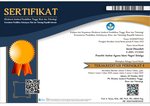Social Classes Reflected By The Main Characters In Kevin Kwan’s “Crazy Rich Asians” Novel
Abstract
The aim of this study is to analyze the disparity of social class and the causes and effects of social class among two main characters in Kevin Kwan’s “Crazy Rich Asians” novel (2013). To analyze the issue, Weber’s theory of social class (1998) were used. The research methodology used in this study was a qualitative method. By using this method, it means a qualitative approach is used to describe the social phenomenon, life experiences and situations to give the meanings and also to explore the behavior, perspectives, experiences, and feeling of people in the form of an essay. Based on the analysis, some aspects that relate to the disparity and causes and effects of social class. Those are the types of social class disparity reflected by these two characters, the cause of social class between the two main characters and the effect that caused by its disparity of social class. The result of this study showed that these disparities can be lifestyle, ways of thinking and in choosing a partner. Also, social class can be caused by heredity and family background, the effects are someone who has a social class that is considered low, will be ostracized, or even terrorized.
Keyword : Qualitative Method, Social Class, Weber Theory.Full Text:
PDFReferences
Aldrigde, S. (2004). Life Chances & Social Mobility. London; Cabinet Office.
Berger, P. (1980). Invitation of Sociology: A Humanistic Perspective. New York; Doubleday Company
Brennan, C. (1997). Max Weber on Power and Social Stratification: An Interpretation and Critique. Aldershot; Avebury.
Chaudhary, A. (2019). Retrieved December 28, 2019 from Bloomberg News: https://www.bloomberg.com/quicktake/india-s-caste-system.
Coser L. (1956). Function of Social Conflict. New York; Free Press.
Denzin, N. & Lincoln, Y. (1994). Handbook of Qualitative Research. California; SAGE Publishing.
Fatmawati, Y. (2014). Eliza’s Struggle to Achieve The Higher Social Class Status in Pygmalion George Bernard Shaw. Surabaya. Faculty of Letters and Humanities.
Giddens, A. D. (2006). Sociology 5th Edition. Cambridge; Polity Press.
Horton, P. B. & Hunt, C. L. (1968). Sociology 2nd Edition. New York; McGraw-Hill.
Jones, E. (1968). Outline of Literature: Short Story, Story: Novel and Poem. New York; The Macmillan Company.
MacIver, R. M. & Page, C. H. (1950). Society: An Introductory Analysis. New York; The Macmillan Company.
Manlove, R. F. (2002). Social Inequality in Urban Philippines. Retrieved January 11, 2020.
Morina. (2013). An Analysis of Social Class and Social Struggle in “The Hunger Games” Movie Using Marxism Theory. Jakarta. English Departement Faculty of Letters.
Perrine, L. (1974). Literature: Structure, Sound and Sense. California; Harcourt Brace Jovanovich.
Pruitt, D. G. (1998). Handbook of Social Psychology (4th ed., Vol.2, pp. 470-503). New York; McGraw-Hill.
Rizal, K. (2017). The Struggle of Lower Class As Seen in “Mad Max: Fury Road”. Yogyakarta. Faculty of Adab and Cultural Science.
Roberts, E. V. (1995). Literature: An Introduction to Reading and Writing. New Jersey; Prentice Hall.
Sill, D. (1972). International Encyclopedia of the Social Sciences. London; The Macmillan Company.
Stiglitz, J. (2012). The Price of Inequality: How Today’s Divided Society Endangers our Future. New York; W. W. Norton.
Sumardjo. (1998). Apresiasi Kesusastraan. Jakarta; PT. Gramedia.
Suseno, F. M. (2001). Pemikiran Karl Marx, Dari Sosialisme Utopis ke Perselisihan Revisisonisme. Jakarta; PT. Gramedia.
Weber, Max. (1998). From Max Weber: Essays in Sociology. Oxfordshire; Routledge Publisher.
Wellek, R. & Warren, A. (1982). The Attack on Literature and Other Essays. North Carolina. The University of North Carolina Pres.
DOI: https://doi.org/10.18326/dinamika.v1i2.1-15
Refbacks
- There are currently no refbacks.
Copyright (c) 2021 Difa Reza Pahlevi, Eka Margianti Sagimin








